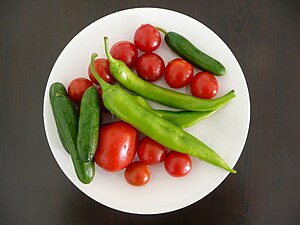 Image via Wikipedia
Image via WikipediaVitamin A is needed for good eyesight and optimal functioning of the immune system. Cod liver oil, dairy products, sweet potatoes and dark green leafy vegetables are all great natural food sources of vitamin A.
Vitamin B1, also known as thiamin, is imperative to the body’s ability to process carbohydrates. Whole grain breads, cereals and pastas have high amounts of thiamin, so you likely get quite a bit of this already.
Riboflavin, or B2, can be found in fortified cereals, almonds, asparagus, eggs, and meat. It’s used in many body processes, including converting food into energy and the production of red blood cells.
Niacin, also known as B3, can be found in lean chicken, tuna, salmon, turkey, enriched flour, peanuts, and fortified cereals. It aids in digestion and also plays a key role in converting food into energy.
Vitamin B6 can be found in fortified cereals, fortified soy-based meat substitutes, baked potatoes with skin, bananas, light-meat chicken and turkey, eggs, and spinach. It’s vital for a healthy nervous system, and helps break down proteins and stored sugars.
Vitamin B12 is needed for creating red blood cells, and can be found in beef, clams, mussels, crabs, salmon, poultry, and soybeans.
 Image via Wikipedia
Image via WikipediaCitrus fruits, red berries, tomatoes, potatoes, broccoli, cauliflower, Brussels sprouts, red and green bell peppers, cabbage, and spinach are all loaded with Vitamin C, which is vital to promoting a healthy immune system, and making chemical messengers in the brain.
Vitamin D can be found in fortified milk, cheese, and cereals; egg yolks; salmon; but can also be made by the body from sunlight exposure. It’s needed to process calcium and maintain the health of bones and teeth.
Vitamin E functions as an antioxidant and is essential to your skin’s good health. Eat plenty of leafy green vegetables, almonds, hazelnuts, and vegetable oils like sunflower, canola, and soybean to get this vital nutrient.
Folic Acid can be found in fortified cereals and grain products; lima, lentil, and garbanzo beans; and dark leafy vegetables. It’s vital for cell development, prevents birth defects, promotes heart health, and helps red blood cells form. Pregnant women need to take special care to ensure they are getting enough of this for themselves and their developing baby.
Dairy products, broccoli, dark leafy greens like spinach and rhubarb, and fortified products, such as orange juice, soy milk, and tofu are all loaded with calcium. Like vitamin D, it’s very important in helping to build and maintain strong bones and teeth. (However, what many people don't know is that milk (especially processed, homogenized, skim milk) is highly acidic, which means it leaches at least as much calcium from your bones as you consume, so be aware of this, and don't make the mistake of thinking that drinking a lot of milk is going to solve your calcium needs.)
Organ meats, oysters, clams, crabs, cashews, sunflower seeds, wheat bran cereals, whole-grain products, and cocoa products are all high in copper, which aids in metabolism of iron and red cell formation. It also assists in the production of energy for cells.
 Image via Wikipedia
Image via WikipediaIron can be found in leafy green vegetables, beans, shellfish, red meat, poultry, soy foods, and some fortified foods. It’s needed to transport oxygen to all parts of the body via the red blood cells.
Potassium can be found in foods like Broccoli, potatoes (with the skins on), prune juice, orange juice, leafy green vegetables, bananas, raisins, and tomatoes. It aids in nervous system and muscle function and also helps maintain a healthy balance of water in the blood and body tissues.
Red meat, fortified cereals, oysters, almonds, peanuts, chickpeas, soy foods, and dairy products are great dietary sources of zinc. Zinc supports the body’s immune function, reproduction capabilities, and the nervous systems.
Protein is the main component of muscles, organs, and glands. Every living cell and all body fluids, except bile and urine, contain protein. The cells of muscles, tendons, and ligaments are maintained with protein. Children and adolescents require protein for growth and development, and adults need it to maintain cell integrity. It can be found in foods like beans, milk and meat.
The primary function of carbohydrates is to provide energy for the body, especially the brain and the nervous system. Complex carbohydrates are the best choice for a stable blood sugar level. Whole grain breads and cereals, legumes, and starchy vegetables are all good complex carbohydrate sources.
Essential fatty acids play a part in many metabolic processes, and there is evidence to suggest that low levels of essential fatty acids, or the wrong balance of types among the essential fatty acids, may be a factor in a number of illnesses. Good sources are fish and shellfish, flaxseed, canola oil, pumpkin seeds, sunflower seeds, leafy vegetables, and walnuts.
Though this list is far from complete, it gives a good base of knowledge on which to build a healthy, well-balanced diet. And if all this just seems too overwhelming to keep track of, just follow the simple rule in this blog post, and make sure you eat a lot of different colors every day!

No comments:
Post a Comment